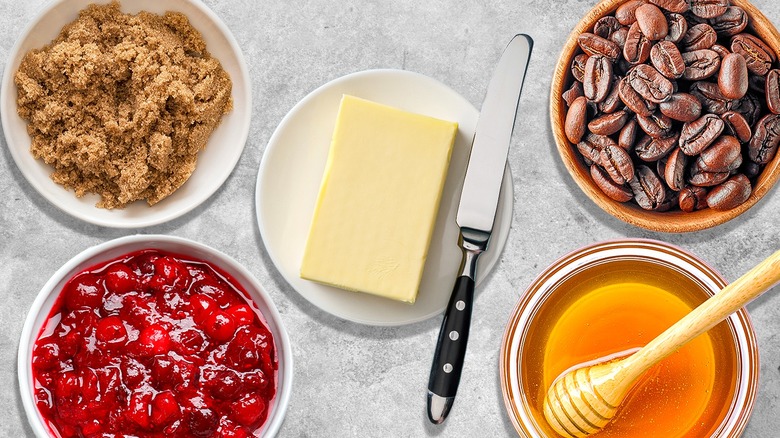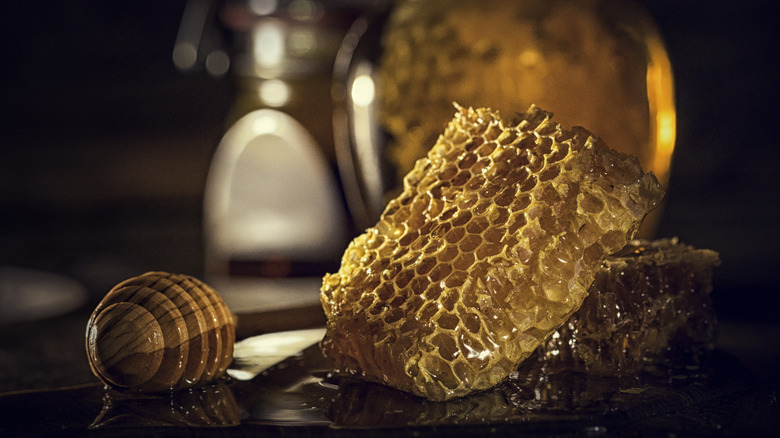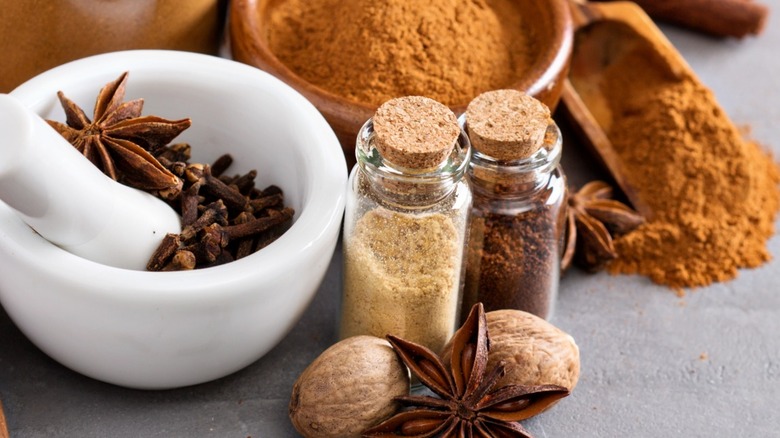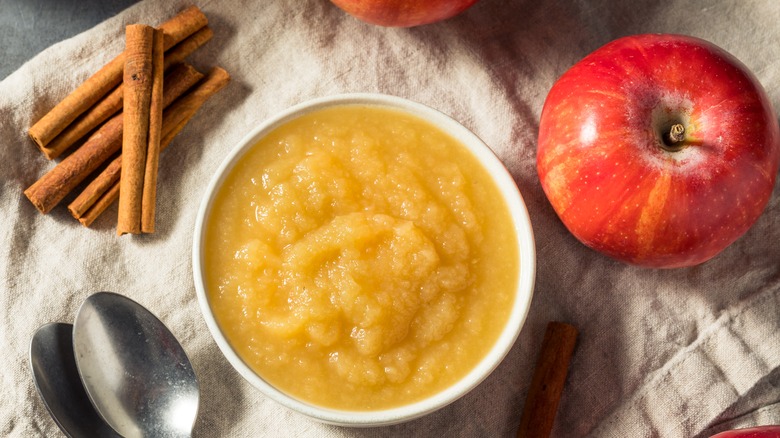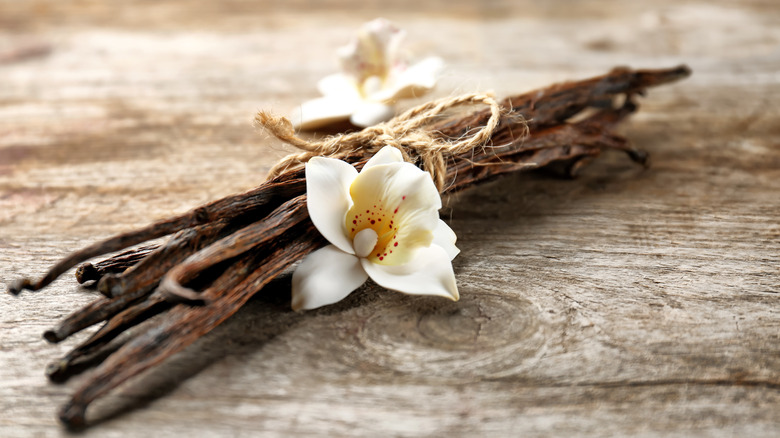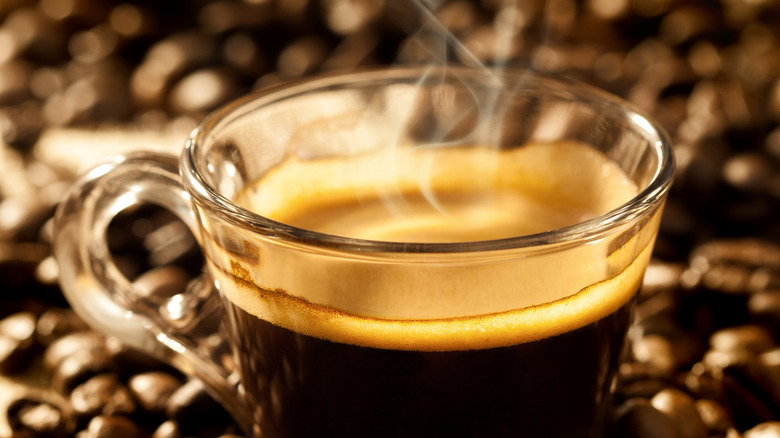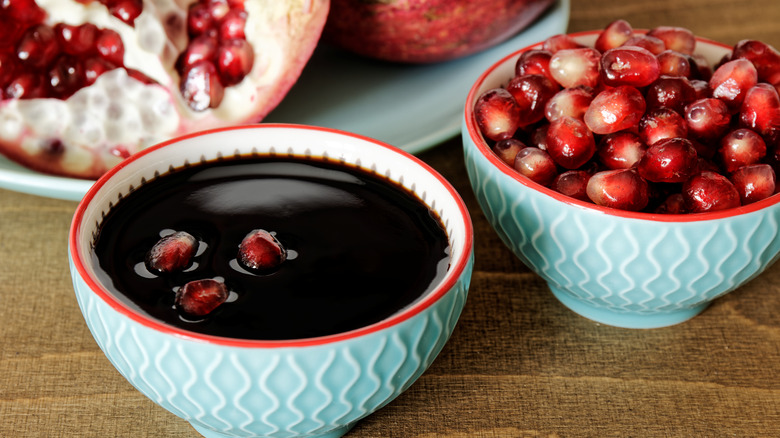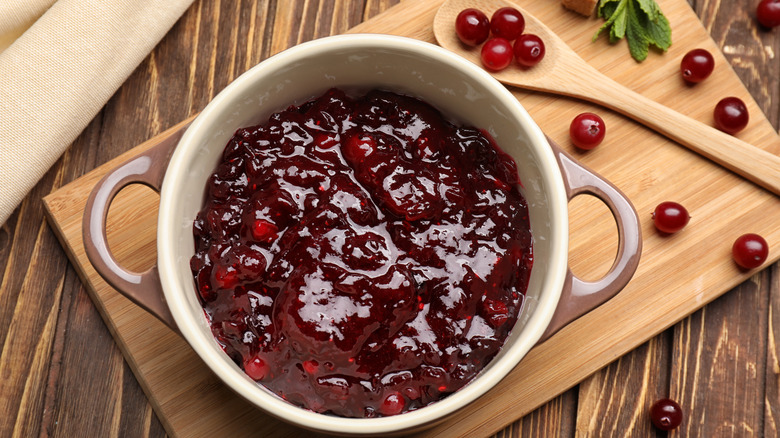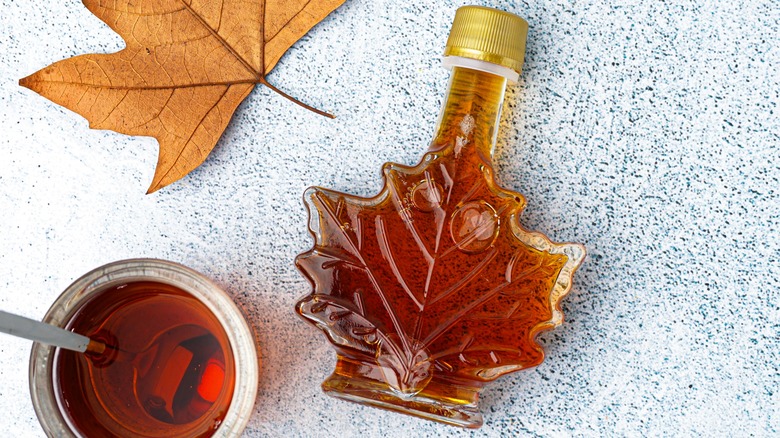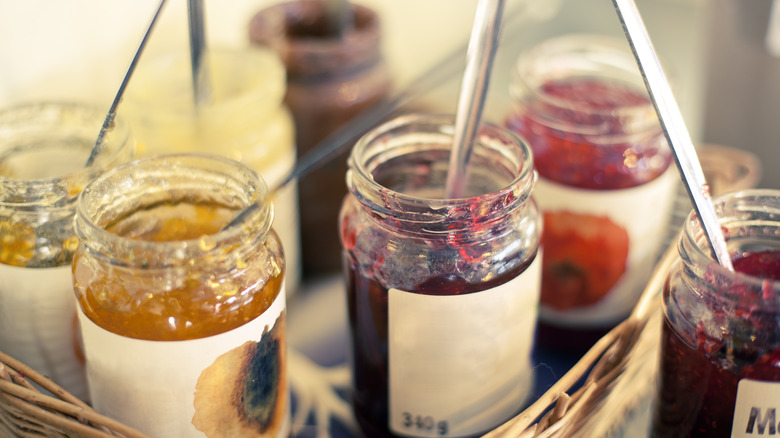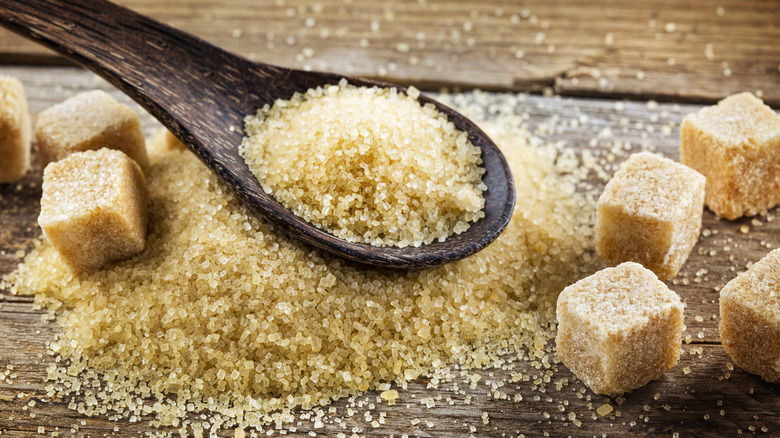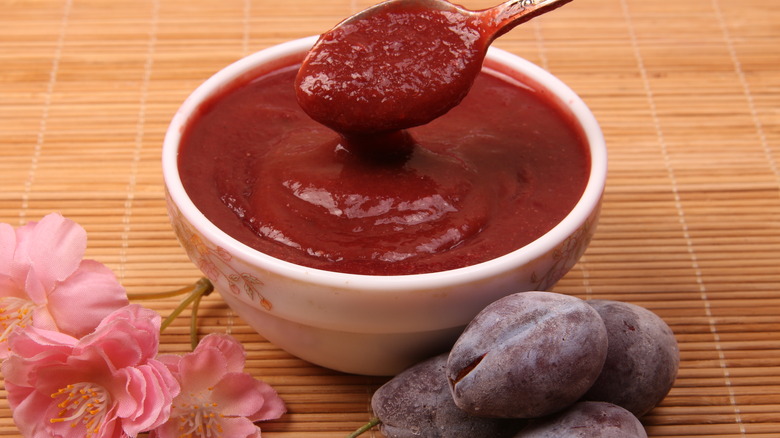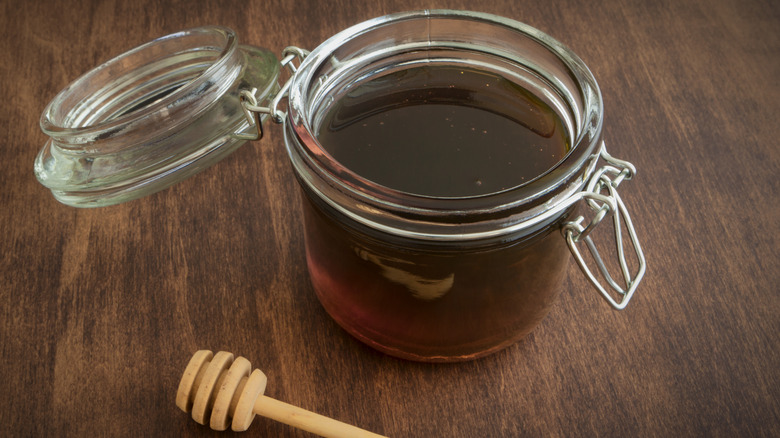14 Sweet Ingredients You Should Be Adding To Your Butter
Have you ever experienced the joy and tastiness of compound butter? If your answer is no, you might be surprised to learn that there's a good chance you've eaten some without even realizing it. Compound butter simply means butter mixed with one or more additional ingredients — so, if you've ever had garlic butter, honey butter, or some fancy-schmancy herbed butter at a steakhouse, then yes, you've eaten compound butter. This infused fat offers a great way to enhance recipes with extra flavor, and making great compound butter at home is a breeze.
Most people think of savory ingredients like garlic, spices, and herbs when it comes to compound butter, but the beauty of butter is that there are plenty of sweet ingredients you can add to it, too. After all, butter is a key baking ingredient, but you can mix and match sweet and savory, as well. Use vanilla beans to elevate butter for a unique take on roasted veggies, for example. Or combine sweetened espresso with butter for the ultimate upgrade to a fresh, flaky croissant. When peach jelly is mixed with butter, it leads to a breakfast spread you won't soon forget. Not convinced yet? We've got 14 incredible sweet ingredients to add to butter to get you started.
Honey
Honey butter is an immensely popular concoction commonly served with biscuits, cornbread, dinner rolls, and other variations of bread, though you can use it just about anywhere you'd use butter. It's especially popular in the Southern United States, but as the joys of Southern cooking have spread, its popularity has surged all over the U.S. — you'll even find it on some fast food chain favorites, such as Chick-fil-A's Chick-n-Mini sliders. The combination of rich, creamy butter and sweet, nectarous honey is a tough one to beat.
Making honey butter is as easy as combining softened butter with honey and using it however you desire. If it's for a recipe that calls for cold butter, allow the fat to soften and mix it with the honey, then put it back into the fridge until it's cold and firm again. Use honey butter to jazz up mini cornbread muffins, add a sweet element to grilled corn on the cob, or take your morning toasted sourdough slice to the next level. To give honey butter even more flavor, consider using hot honey for a kick or adding additional ingredients, the way we do in this honey-curry compound butter recipe.
Baking spices
Dried spices offer one of the easiest ways to elevate butter — no toasting spices or mincing fresh herbs required here. Dried herbs, alliums, and peppers are fantastic choices for savory compound butters, but for a sweet butter, dried baking spices are the way to go. Baking spices include aromatic ingredients like cinnamon, ginger, allspice, cloves, and nutmeg. The term also includes mixed seasonings such as pumpkin pie spice which, contrary to popular belief, does not contain pumpkin but rather a mix of ground cinnamon, nutmeg, cloves, and ginger.
Ground baking spices can easily be churned into softened butter with a dash of sugar to bring additional sweetness, and applications are endless from there. Give your molasses ginger cookies a snap by infusing your butter with cloves. Hop on the butter coffee bandwagon and DIY a pumpkin spice butter coffee with pumpkin spice-infused butter. Impress your family at Thanksgiving dinner by mixing ginger butter in with your mashed sweet potatoes, or set out a dish of soft, slightly sweet, creamy cinnamon butter for diners to enjoy with their dinner rolls.
Applesauce
Apple butter doesn't quite qualify as a compound butter as it involves slowly cooking down butter with many other ingredients, but nonetheless, the combination of roasted apples and rich butter offers peak fall vibes. If you're craving apple-forward butter, but don't have the time or desire to make a complex recipe like this roasted chai apple butter, applesauce butter is a great alternative. The crisp, warm flavors of applesauce meld deliciously with softened butter and preserve the consistency of butter well enough that it can be used in place of plain butter in baking recipes.
Also, butter mixed with applesauce makes a great addition to a charcuterie board — spread it on a buttery cracker with sweet Brie and some hot honey for a flavor sensation that you'll keep coming back for more of. Use it to elevate your favorite cookie and cupcake recipes, or warm it up and toss root vegetables like sweet potatoes, beets, carrots, or whatever you're craving, in it before cooking for a pleasantly sweet, savory, and earthy combo.
Vanilla beans
Vanilla is often thought of strictly in terms of sweet dishes — vanilla ice cream, anyone? — yet the aromatic spice has an incredibly nuanced flavor profile that compliments savory foods just as well. Vanilla extract is highly accessible in supermarkets these days, but vanilla beans are the way to go if you want the richest, freshest, deepest flavor. Vanilla beans, while pricey, lend their sweet, delicate, earthy flavor beautifully to everything from marinades to seafood. If you're still apprehensive about using them in savory dishes, adding vanilla beans to your butter is a great place to start experimenting.
Vanilla beans are the tiny black dots that you scrape out of a vanilla pod. For the best results, infusing butter with them requires a little more effort than just mixing them in. Cook the beans with a stick of butter over low heat and allow the butter to brown to add another layer of caramelly, nutty flavor. The beans will simultaneously infuse the entire mixture with their rich sweet and aromatic qualities. The result is a vanilla-infused brown butter perfect for roasting your fave veggies, dipping crusty bread into, or adding to a pasta sauce. You can add some powdered sugar if you're looking for a super-sweet result.
Sweetened coffee
While most people take their coffee in liquid form, ground coffee can be used to elevate spice rubs, brownies, beauty products (you haven't lived till you've tried a coffee foot scrub), and more. Sweetened ground coffee, including naturally sweet varieties and flavored versions like vanilla or hazelnut, can be combined with butter for a sweet coffee butter breakfast spread. This recipe marries the mellow, creamy flavor of butter with coffee's rich, earthy, slightly bitter taste for a scrumptious, caffeine-blasted holy union. Simply add sugar for a sweeter result.
While coffee is the star of the show, feel free to add a pinch of nutmeg, cinnamon, ginger, or other baking spices to give your coffee butter even more oomph. This spread is *chef's kiss* when dolloped on pancakes, waffles, toast, and all things breakfast food; or get weird with it and use the turbo-loaded mixture to upgrade sandwiches, BBQ plates, and cheese boards. While the amount of caffeine here is low, if you're sensitive to stimulants, you may want to limit your consumption of coffee butter to mornings and early afternoons.
Pomegranate molasses
Pomegranates are tasty, unique, and highly versatile fruits. The arils are wonderful when used to garnish salads, added to sauces and glazes for lamb, or stirred into the juice for a fun take on a mimosa. Pomegranate molasses is a syrupy condiment made by boiling and reducing pomegranate juice to a sweet sticky consistency. It's used to add the ruby fruit's signature tart and sweet notes to a variety of dishes. Found all over the Middle East, you can buy it here in some grocery stores or easily make it at home.
Combining pomegranate molasses and butter leads to a magically sweet, creamy, lightly acidic spread perfect for jazzing up pancakes, roasted Brussels sprouts, or a bougie grilled cheese. Seriously — the sweetness of the pomegranate makes an excellent foil for many cheeses, especially goat cheese and creamy Brie. Ramp up your pomegranate molasses butter by adding citrus zest or dried spices during mixing.
Cranberry sauce
Nothing says Thanksgiving like cranberry sauce. Whether you're a straight-from-the-can guy or a DIY sweating-over-the-stove cranberry sauce gal, it's an essential part of the holidays. Cranberry sauce's mouth-puckering sweetness offers a nice alternative to the rich, heavy foods traditionally served at such meals (think turkey, gravy, and mashed potatoes) while adding a pop of color to plates that are heavy on the beige. While cranberry sauce is delicious, not everyone enjoys it, and many times, holiday hosts find themselves with excess sauce after a family and friends feast. In such a situation, it's time to whip up some of Martha Stewart's two-ingredient cranberry butter.
This pretty and pink spread requires only room-temperature butter and cranberry sauce whipped together in a food processor for a sweet, tart, buttery treat — and c'mon, if Martha Stewart is recommending it, you know it's gonna be good. Stewart suggests serving cranberry butter with muffins or cornbread, but you could also slather it on leftover Thanksgiving turkey sliders, use it to top off French toast, or munch on it with crackers and cheese.
Maple syrup
Pure maple syrup might just be nature's best all-natural sweetener. Compared to others, like honey or agave, maple syrup has a distinctive nutty, caramelized, candy-like flavor that lends itself beautifully to everything from bacon to bourbon. When maple syrup is blended into softened butter, the finished product is a rich, sweet, salty (if salted butter is used) concoction that harmonizes perfectly with a wide variety of sweet and savory foods.
If your sweet tooth is calling, use maple butter to make a delicious buttercream frosting for cupcakes, incorporate it into a pancake and bacon brunch at home with friends, or add it to your favorite fall cookie recipes. If you're more of a savory person, maple butter complements steak well, or you can eat it with cornbread muffins or a BLT — the sweet maple jives with smoky, salty bacon and fresh, crunchy lettuce. Maple butter keeps well in the fridge or freezer, so if you don't use it all, save some for next time.
Jellies and jams
Can't decide between butter or jelly on your morning slice of toasted multigrain? Make like Hannah Montana and get the best of both worlds by mixing softened butter with your favorite jelly or jam. Jelly butter is highly versatile in that there's a huge number of different jams and jellies available at grocery stores, farmer's markets, specialty gift shops, and elsewhere. From classic Smucker's strawberry jam to the zippy handmade habanero rhubarb jelly you snagged from that sweet lady at the art market, jelly butter is super customizable to your preferences.
Use butter mixed with blackberry jam to magic together an out-of-this-world goat cheese grilled cheese sammie. Slather hot pepper jelly butter on cornbread to blow your guests' minds the next time you host a chili cookoff. Go the savory route and whip up a tomato bacon jam butter to elevate fluffy, flaky croissant breakfast sandwiches, or keep it simple by spreading strawberry jelly butter on a bagel for a grab-and-go breakfast. Experiment with adding additional ingredients, like orange zest, sriracha, or ground coffee, to your jelly butter for even more specialized flavors.
Sweetened tea
Most compound butters rely on solid ingredients, but liquids can be mixed with butter just as well. Sweetened tea is a brilliant example of an underrated ingredient for elevating compound butter that might seem odd, but in practice lends a certain sophisticated, elevated taste to plain butter. Tea is easy to mix with butter — brew tea to your desired strength, allow it to cool, then mix the tea with softened butter with some loose tea grounds (grind the grounds to a fine consistency so you don't have chunks throughout the butter).
Sweet tea butter can be made with any type of sweetened tea you desire. Chamomile tea offers mellow, fruity notes, chai tea comes with bold, aromatic spices. There are hundreds of varieties of black, green, herbal, and specialty teas to choose from depending on whether you're going for fruity, floral, bitter, or tart. Sweet tea butter is the perfect way to spice up a classy tea party with scones, muffins, and biscuits, or simply use tea butter to spruce up your morning English muffin.
Brown sugar
Brown sugar and butter are a match made in heaven. Brown sugar's warm, deep, toffee-like flavor perfectly complements creamy butter, and the sweet-and-rich combination offers the perfect way to kick off your day. Simply combine light or dark brown sugar with room-temperature butter at a 1:1 ratio, and you've got an easy, tasty spread. Brown sugar butter is a great way to use up that extra tablespoon or two of brown sugar left in the bag when you've been baking up a storm — it keeps well in the fridge or freezer, so there's no need to use it all at once.
You can use brown sugar butter anywhere you like, but it's particularly divine when acting as a secret ingredient for perfectly buttered toast. Slather brown sugar butter on both sides of a piece of bread and fry it in a skillet for a few minutes on each side so that the brown sugar caramelizes and becomes crispy when cooled. You'll never want to eat toast any other way again.
Booze
If you want to blow your dining companions' minds with a truly special and elevated compound butter, you can't do much better than spirits. Adding booze to butter unlocks a world of possibilities given the myriad types of liquor available. Different alcoholic drinks have wide-ranging flavors depending on the type of spirit, aging duration, making method, and brand you're working with. Subsequently, batches of boozy butter will taste different depending on what kind of alcohol you're infusing it with — something to keep in mind depending on the recipe you're trying to jazz up with this one-of-a-kind butter. And if you want to up the sweetness, on top of the alcohol's natural sugars, simply mix in some powdered sugar, too.
Whiskey's woodsy, sweet, and lightly spicy notes help create a compound butter perfect for grilling meats, while reposado tequila's floral, lime-forward flavor adds a nice zip when cooking fish or shrimp for tacos. Rum butter will take baking recipes to the next level, or use red or white wine butter to elevate everything from beef bourguignon to pasta sauce. Different types of beer make compound butters infused with flavors of malt, cereal grains, or citrus, while hard cider is great for lending sweet apple notes to a fall-forward butter.
Plum sauce
A fundamental ingredient in Chinese cuisine, plum sauce is a fruity, slightly spicy, tart sauce with a sticky consistency similar to BBQ sauce. Its flavor bears some resemblance to hoisin sauce, but there's a big difference between plum sauce and hoisin. Although both condiments are made with sugar, garlic, chile, and vinegar, hoisin contains fermented soybeans and starch while plum sauce contains (you guessed it) plums, giving it a much sweeter flavor.
Supplementing your room-temperature butter with plum sauce leads to a sweet, lightly tangy compound butter you won't be able to stop eating. It's the perfect way to infuse fried rice with a burst of surprising fruity flavor, but it's also fantastic for grilling pork chops, spreading on burger buns, or drizzling on carrots before roasting for an earthy and sugar-forward side dish. Use add-ons like dried spices, fruit juices, and citrus zest to experiment with additional flavor in plum sauce butter.
Sorghum syrup
Sorghum is a grass crop grown all over the world and consumed in many different manners, but in kitchens across the American South, it's common to crush sorghum stalks and boil them down into a sticky, molasses-like concoction known as sorghum syrup. Sweet, mineral sorghum syrup is a popular choice for drizzling on biscuits and cornbread, but a sorghum butter combo is the honey butter alternative you probably never knew you needed until now.
Whipping salted butter and sorghum syrup together creates a fluffy, light-as-air butter with a rich sweetness rivaling that of honey or maple syrup butter. In the South, sorghum butter is commonly associated with biscuits, and while this is certainly a delectable choice, this compound butter also works well with mashed sweet potatoes, and fried chicken. Similar to honey butter, you can take sorghum butter up a notch by adding chiles, additional spices, coffee grounds, spirits, or whatever else floats your fancy.
